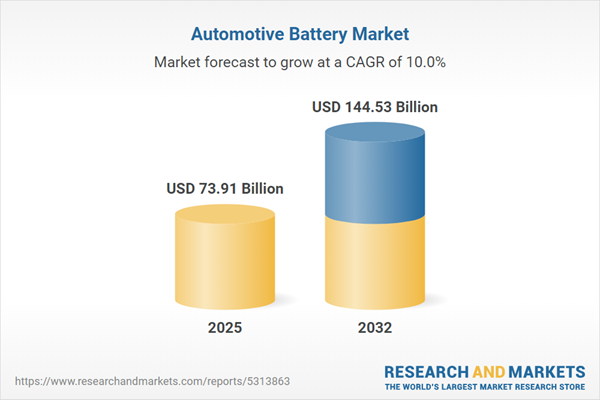Speak directly to the analyst to clarify any post sales queries you may have.
The automotive battery market is experiencing fundamental shifts as technology innovation accelerates, regulations tighten, and industry supply strategies adapt. Leaders across the sector now require strategic agility to navigate this evolving environment, making timely, data-driven decisions that protect competitive advantage.
Market Snapshot: Automotive Battery Market Overview
In 2024, the automotive battery market achieved a valuation of USD 67.56 billion, with industry forecasts projecting growth to USD 73.91 billion by 2025 and further expansion to USD 144.53 billion by 2032. This projected expansion, reflecting a CAGR of 9.97%, is underpinned by increased capital investment, strategic alliances, and continuous advances in energy storage. Companies increasingly deploy agile procurement approaches and emphasize operational flexibility in response to these evolving market drivers. Organizations are focusing on adaptive manufacturing and regulatory compliance readiness, aiming to capture market opportunities and mitigate emerging risks amid ongoing change.
Scope & Segmentation: Automotive Battery Market
This analysis delivers executive-level segmentation and pragmatic market context for senior leaders formulating strategies in a rapidly evolving sector:
- Battery Type: Encompasses Lead Acid, Lithium-Ion, Nickel-Metal Hydride, and Sodium-Ion technologies, each shaping cost structure, expected lifecycle, and adherence to safety and performance standards in distinct vehicle categories.
- Drive Type: Includes infrastructure for both Electric Vehicles and Internal Combustion Engine models, equipping organizations to manage mixed vehicle fleets and navigate ongoing mobility transitions.
- Vehicle Type: Covers commercial vehicles, hatchbacks, sedans, and SUVs, enabling tailored go-to-market and compliance strategies for manufacturers and suppliers addressing diverse automotive platforms.
- Application: Spans Ancillary, Auxiliary, and Propulsion uses, offering benchmarks for energy efficiency, system integration, and adaptability across evolving vehicle architectures.
- Sales Channel: Compares Direct and Distributor distribution models, guiding leaders on optimizing supply partnerships and maximizing channel effectiveness along the value chain.
- Regional Coverage: Addresses global market dynamics in the Americas, EMEA, and Asia-Pacific, supporting the alignment of strategies with the maturity of regional infrastructure, regulatory movements, and varying adoption rates.
- Key Companies Profiled: Features Exide Industries Limited, General Motors Company, GS Yuasa Corporation, Hitachi Ltd., LG Energy Solution Ltd., Mitsubishi Corporation, NEC Corporation, Okaya Power Pvt. Ltd., Panasonic Holdings Corporation, Robert Bosch GmbH, Samsung SDI Co., Ltd., Tata Motors Limited, Tesla Power USA LLC, Tianneng Group, and Toshiba Corporation. These leading firms illustrate the evolving partnership and competitive landscape.
Key Takeaways: Strategic Insights for Senior Decision-Makers
- Rapid battery technology advancements are prompting organizations to strengthen operational capabilities and enhance aftersales services to remain responsive to evolving market demands.
- Integrating development pipelines with technology partners accelerates product launches and helps organizations quickly align with shifting consumer preferences and emerging vehicle requirements.
- Complex regulatory landscapes require the creation of resilient, adaptable supply networks, positioning operational flexibility as central to market leadership and long-term stability.
- Greater vertical integration across procurement and manufacturing secures supply reliability, allowing enterprises to navigate disruptions and support sustained growth across their global footprint.
- Adjusting operations to local policies and diverse infrastructure environments optimizes resource deployment and strengthens risk management in high-variability contexts.
- Focused investment in R&D and diversified supplier ecosystems supports managed progression toward electrification and positions firms to anticipate and address value chain disruptions.
Tariff Impact: US Market and Supply Chain Dynamics
Recent changes in US tariff policies have spurred automotive battery manufacturers to increase domestic sourcing and localize production. In response, companies are forming new regional alliances and prioritizing battery recycling within US supply chains. These strategies enhance access to raw materials and regulatory compliance, underlining the importance of agile procurement and distribution practices as supply chain models evolve.
Methodology & Data Sources
This report harnesses a comprehensive suite of resources, including executive interviews, technical analyses, and regulatory reviews, underpinned by rigorous market research standards. This approach ensures actionable, timely market intelligence for organizations navigating the dynamic automotive battery landscape.
Why This Report Matters for Decision-Makers
- Supplies precise segmentation and expert analysis to inform investment, risk mitigation, and strategic adaptation in a shifting industry context.
- Gives organizations the clarity to update strategies in alignment with regulatory and technological change, supporting continuous operational and portfolio strength.
- Improves transparency and resilience across supply chains, supporting executive management of ongoing operational continuity.
Conclusion
This report offers business leaders actionable market segmentation and relevant strategic guidance to inform decision-making, support growth, and build robust strategies amid ongoing transformation in the automotive battery market.
Additional Product Information:
- Purchase of this report includes 1 year online access with quarterly updates.
- This report can be updated on request. Please contact our Customer Experience team using the Ask a Question widget on our website.
Table of Contents
3. Executive Summary
4. Market Overview
7. Cumulative Impact of Artificial Intelligence 2025
Companies Mentioned
The companies profiled in this Automotive Battery market report include:- Exide Industries Limited
- General Motors Company
- GS Yuasa Corporation
- Hitachi, Ltd.
- LG Energy Solution Ltd.
- Mitsubishi Corporation
- NEC Corporation
- Okaya Power Pvt. Ltd.
- Panasonic Holdings Corporation
- Robert Bosch GmbH
- Samsung SDI Co., Ltd.
- Tata Motors Limited
- Tesla Power USA LLC
- Tianneng Group
- Toshiba Corporation
Table Information
| Report Attribute | Details |
|---|---|
| No. of Pages | 196 |
| Published | November 2025 |
| Forecast Period | 2025 - 2032 |
| Estimated Market Value ( USD | $ 73.91 Billion |
| Forecasted Market Value ( USD | $ 144.53 Billion |
| Compound Annual Growth Rate | 9.9% |
| Regions Covered | Global |
| No. of Companies Mentioned | 16 |









